Our travel to Kyushu was in November 2022.
Check the full planning on the left, you have direct access to each of the parts of this guide.
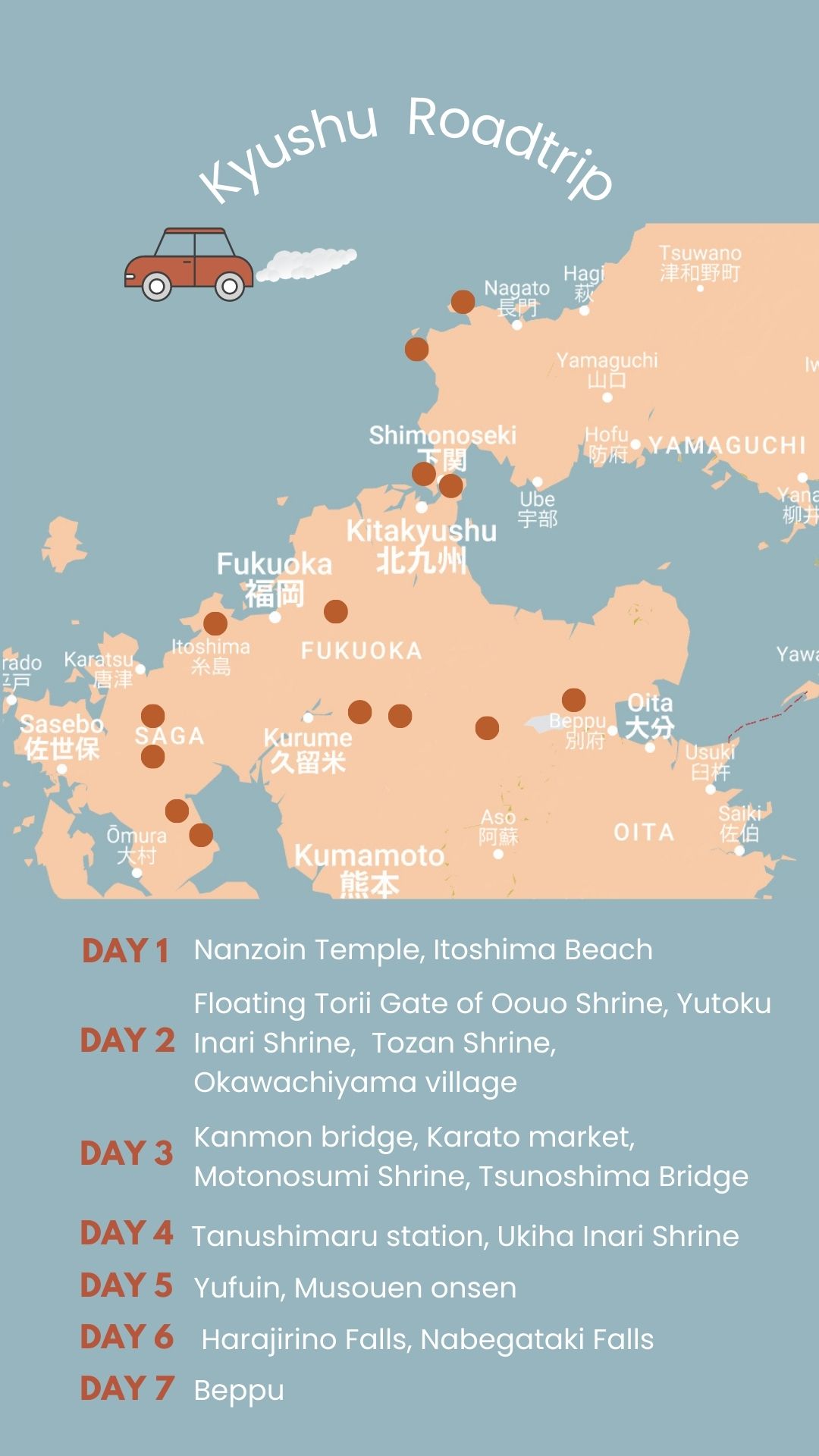
Planning for 7 full days:
- DAY 0: Getting to Kyushu (Hakata Station), night in Fukuoka
Getting to Fukuoka | Renting a car
Accommodation in Kyushu - DAY 1: Fukuoka - Rent the car, Nanzoin temple & Itoshima beach, night in Fukuoka
Visits | Eating - DAY 2: Saga - Floating Torii Gate of Oouo shrine, Yutoku inari shrine, Tozan shrine and Okawachiyama village, night in Fukuoka
Visits | Eating - DAY 3: Yamaguchi - Kanmon bridge, Karato Market, Motonosumi shrine, Tsunoshima bridge, night in Fukuoka
Visits | Eating - DAY 4: Fukoka - Tanushimaru kappa station, Ukiha Inari Shrine, night in Yufuin
Visits | Eating - DAY 5: Oita - Yufuin, Musouen Onsen, night in Yufuin
Visits | Eating - DAY 6: Oita - Harajirino falls, Nabegataki Falls, night in Yufuin
Visits | Eating - DAY 7: Oita - Beppu, night in Fukuoka
Visits | Eating
Kyushu is the third largest island of Japan and is located in the southwestern part of the country. It's the southernmost of the main islands, excluding Okinawa, which is further to the south. It is known for its stunning natural beauty, including active volcanoes like the Aso volcano, specially the hot springs, and some scenic incredible beaches (you'll see!). Kyushu is also famous for its rich culture and history, and has been the birthplace of many influential cultural and artistic movements that are now representative of all Japan, like the Japanese pottery that was in fact born in Saga. Kyushu is also known for its delicious cuisine, including the famous tonkotsu ramen, which is a pork bone soup-based noodle dish, and motsunabe, a hotpot made with beef intestines. If you are interested into exploring a new area that is off the beaten path and want to immerse yourself in the most traditional Japanese culture or explore the stunning landscapes of Kyushu, you'll fall in love with this beautiful island, keep reading to organize your trip following our itinerary!
We visited Kyushu during our last trip to Japan, which was our fourth time visiting the country. We originally planned to visit all the island, but soon realized that we didn't have enough time with only one week (at least, you need around 12 days). So, we narrowed it down to the northern half. We are definitely going to visit the southern half as soon as we can return ;)
HOW TO GET HERE, CAR RENTAL INFORMATION

GETTING TO FUKUOKA
TRAIN
The most convenient way to get here is by rail transportation using the Shinkansen, from any major station to Hakata Station. We decided to use the first day of our trip (our arrival day) to travel all the way from Tokyo's Shinagawa Station to Fukuoka's Hakata Station. The direct Nozomi Shinkansen from Shinagawa takes 4 hours and 45 minutes. Unfortunately, this type of train is not covered by the Japan Rail Pass, so if you want to use the pass, you will have to take two trains, changing at Shin-Kobe. The two trains are the Shinkansen Hikari and Sakura, both of which are included in the JRP. The total trip time is then 5 hours and 40 minutes. If you are not using the JRP, the first option is the best since both options cost the same, approximately 100€ or 14080 ¥ per person
PLANE
However, if you prefer to travel by plane, you can also fly directly to Fukuoka. But I find this option to be even longer due to security checks and wait times
Tip: If you have the opportunity, you can also fly directly to Osaka from your country. The train ride from Osaka to Kyushu only takes 2 hours and 22 minutes.
RENTING A CAR
Renting a car is not necessary to visit Kyushu, but we decided that it would give us more freedom and easy access to some of the places we are covering in this guide. We will explain in each place whether it is possible or not to visit using public transportation and how, so don't worry if you don't want to rent a car. You can still follow this guide, although you may miss out on some spots.
We rented the car from Toyota Rent a Car and I highly recommend them. We had a wonderful experience with the rental process, getting the car, and returning it. Everything was very easy, even with limited knowledge of Japanese.
To reserve the car, you don't have to pay anything in advance, so as soon as you know your travel dates, I would recommend making a reservation. You can choose any location near your hotel or Hakata Station.
We recommend reserving the following: A Keio car (as the roads are narrow!), full insurance (which doesn't add much to the price and is a no-brainer), and an ETC card (so you don't have to worry about paying each time; you can pay the final rental fee directly to Toyota at the end of your rental period).
We found the rental price to be very affordable compared to rentals in Spain. Our 7-day rental cost 350 euros, including full coverage and road assistance insurance. However, the highways are more expensive, so expect to pay around 150€ for that concept alone.
ACCOMMODATION IN KYUSHU

The lively Hakata
We decided to base ourselves in Hakata and make daily excursions to explore the northern part of Kyushu. To minimize the hassle of changing accommodations, we decided to stay at two hotels throughout the entire trip. Our hotel of choice in Hakata was The Lively, which offers modern small rooms with no views but the best location.We decided not to include breakfast as we hit the road early each day and instead made use of 7/11s for our meals. However, the hotel's breakfast space was very nice!.
It's worth noting that parking for car rentals like ourselves is not included in the room rate. The hotel offers a convenient parking lot inside the building for 12€ per night, which can be reserved in advance for the duration of your stay. The parking is in a vertical storage system and was a new experience for us as first-timers using this technology that I named "the wheel". You can see it in action on our Instagram stories.
When the text mentions "night in Fukuoka", it refers to staying at The Lively hotel in Hakata.
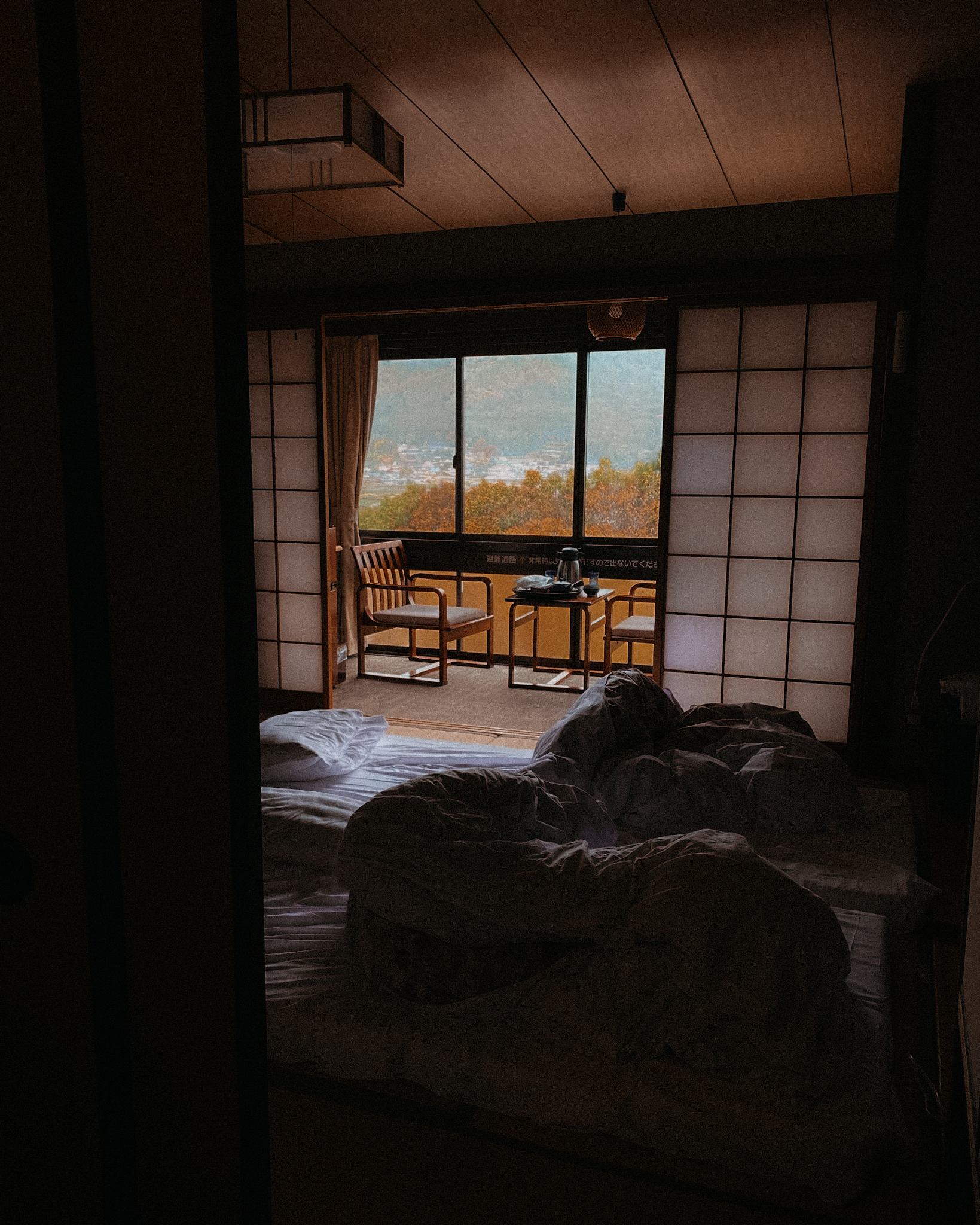
Musouen Onsen
The Musouen was a truly special and worthy splurge to celebrate our wedding anniversary, and it may well be the best hotel experience I'll ever have. If you're visiting Kyushu, I highly recommend booking at least one night at this hotel – it's simply amazing and will make your trip unforgettable.
The Musouen is a traditional onsen hotel, offering a true traditional hotel experience, including rooms with tatami mats and futons for sleeping, as well as yukatas and sandals for use within the hotel. The onsens are the highlight of the hotel, with one large women's bath (which is amazing), one men's bath divided into two sections, plus two external private baths and two covered private baths. To reach the onsens, you'll be surrounded by beautiful greenery, which is particularly stunning during the autumn season. In addition, each night you'll enjoy a kaisikei dinner with local specialties that are both delicious and traditional, and a traditional breakfast in the morning. These meals are so generous and filling that during our stay, we only snacked in between the two big meals.
When the text mentions "night in Yufuin", it refers to staying at The Musouen.
TIP: If spending three nights at The Musouen impacts your budget too much, consider staying one night and choosing a simpler hotel for the remaining two nights, also in Yufuin (as there are many options). Or, stay at a simpler hotel for all three nights and visit The Musouen during the day as an external guest to use the onsens from 10:00 to 14:00 (only!) for a fee.
DAY 1: Nanzoin temple & Itoshima beach, night in Fukuoka - FUKUOKA PREFECTURE -

VISITS
We kicked off our day in Fukuoka by renting a car, we rented the car this same morning to decrease the rental period in 1 day. This was our first time driving in the region, and we were excited for the adventure!
For the first day, we planned to visit the Nanzoin Temple in the late morning, enjoy lunch near the Itoshima beach, admire the sunset at Futamigaura beach, and have dinner in Fukuoka.
TIPS FOR THIS DAY
Fukuoka is larger than anticipated, larger than Barcelona, and there are toll roads within the city that you must use to leave the city. Keep in mind that you will have to pay each time you enter.
The Nanzoin Temple has a designated parking lot located just across the road, so don't miss the sign for the parking. It costs 200 ¥. Additionally, don't miss the piano on the bridge before crossing the road to the temple.
For parking at the Itoshima Beach, there are several options available, but we recommend parking in front of the beach for convenience. Please note that this is a paid parking area and operates on a trust system, where you leave the payment in a mailbox.
One of the great benefits of driving to Itoshima beach is the shorter commute time and the ability to stop at the Sunflower restaurant before reaching the beach, as we did. Check out more information below."

NANZOIN TEMPLE
The temple of the big reclining buddhaNanzoin is a breathtaking Buddhist temple that is home to the world's largest bronze sculpture, a reclining Buddha that measures 40m in length and 11m in height. We were impressed not only by the sheer size of the statue but also by the intricate details and beauty of the temple as a whole. Make sure to also take a moment to appreciate the warrior Buddha on your visit to Nanzoin.
One of the highlights of my experience at Nanzoin was simply sitting in front of the reclining Buddha, enjoying a matcha soft ice cream from the shop, and observing the local worshippers and visitors taking photos. It was a peaceful and memorable moment that I would also recommend to others visiting the temple.
ACCESSIBLE VIA PUBLIC TRANSPORT?
Yes. Take a train from Hakata Station to Kidonanzoin mae station.

ITOSHIMA BEACH
Mindblowing sunsetVisiting Futamigaura Beach, also known as Itoshima Beach, is a must-see in Fukuoka. The best time to visit is at sunset for the most beautiful photos. Although you may find more people at this time, it's well worth the wait. The highlight of the beach is the Sakurai Futamigaura's Couple Stones, two stones tied together symbolizing eternal love and the white torii on the water. Don't miss this romantic spot!
ACCESSIBLE VIA PUBLIC TRANSPORT?
Yes. Take a train from Hakata station to Imajuku station, then take a bus to Nishinoura stop (and walk 23 minutes). It's a long 1h30 minutes journey to here (or 2h if you are at Nanzoin). Make sure to check the bus schedule to get back to Hakata station.


EATING
If you know me well, you're already know of my love for incorporating food experiences into my travels. I believe that it significantly enhances the overall memories as we tend to reminisce about the delicious sukiyaki we had at the Onsen hotel or that mouth-watering pizza slice from New York City. Our foodie journey in Kyushu got off to a fantastic start with the seafood curry from Sunflower and the Motsunabe in Fukuoka!
LUNCH
Sunflower restaurant has a tropical beach feel, reminiscent of Hawaii. It boasts a lovely terrace with ocean views and a beautiful white wooden structure and seating. During the weekdays, they offer lunch menus, and we opted for the seafood curry, which was outstanding. The menu included a vegetable soup (which was just okay, nothing special) and a salad with a delicious citrusy vinaigrette, a common dressing in Japan. The standout dish, however, was the curry. It was fresh and full of flavor. If you're dining with kids who don't like curry (can you believe it?), they also offer pizzas. Eating our food while watching the sea and feeling the warmth of the winter sun was truly a perfect experience.
DINNER
Hakata Motsunabe Maedaya website
For dinner, we headed back to Hakata and chose a restaurant specializing in the local delicacy called Motsunabe: Hakata Motsunabe Maedaya. Motsunabe is a soup or nabemono (as it's called in Japan) made with beef or pork tripe, and you can add some noodles to finish the soup. You definitely have to try this dish! I was initially hesitant about eating tripe, but it turned out to be extremely delicious. We also tried another Fukuoka delicacy, the Mentaiko (cod roe), which is one of those dishes you have to try to understand what all the hype is about. This place was quite popular, with a line and limited seating, so I recommend coming here early in the evening or making a reservation in advance. We arrived early and were the last ones accepted for that night. Only four tables were available without a reservation, and we waited for about an hour.

DAY 2: Floating Torii Gate of Oouo shrine, Yutoku inari shrine, Tozan shrine and Okawachiyama village, night in Fukuoka - SAGA PREFECTURE -

VISITS
For the second day in northern Kyushu, we switched prefectures and visited the picturesque rural area of Saga, known for its artisan ceramics. We started by driving from our hotel to the southern part of Saga and then traveled north. Driving through Saga was a beautiful experience, and the day was filled with several fascinating visits, including a unique photo spot at the floating torii gate of Oouo Shrine, the picturesque Yutoku Inari, one of the most beautiful shrines in Japan, the only shrine with a ceramic torii, Tozan, and the birthplace of Japanese ceramics, Okawachiyama.
TIPS FOR THIS DAY
Having a car for this day is highly recommended. While some of the places are accessible by public transportation, it is important to note that you will have to limit yourself to visiting only 2 sites, as the last train back is at 16:30. Without a car, following the itinerary as outlined in the guide is not feasible.
When you leave Saga, don't forget to take a piece of its beautiful ceramics with you! A must-visit shop is the Tozan Shrine's own shop, which sells charming little figurines made by local artisans. These figurines are both lucky charms and adorable souvenirs.

Floating Torii Gate of Oouo shrine
Unique off the beaten path photo spotThis one-of-a-kind shrine transforms with the changing tides. When the tide is low, as it was during our visit at 9am, you can walk up to the last red gate and see the shells scattered along the path. I even found a small ceramic piece from a cup among the shells that I was able to keep as a memento.
Bonus 1: You will find wooden hearts placed for use as photo props, what a nice idea! Bonus 2: We had breakfast in one of the red picnic tables they have just in front of the gates.
ACCESSIBLE VIA PUBLIC TRANSPORT?
No
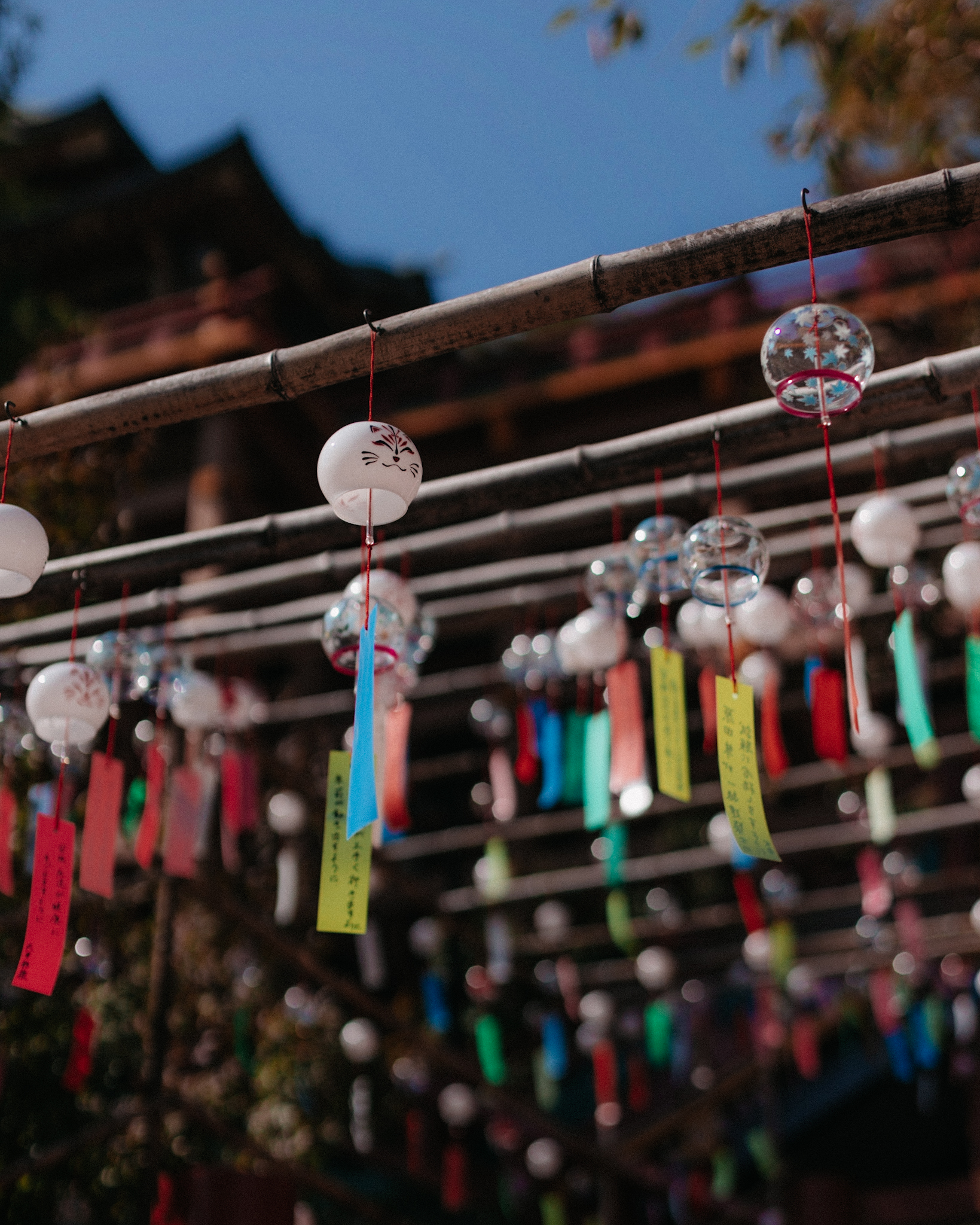
Yutoku inari shrine
One of the most beautiful shrines in JapanYūtoku Inari Jinja in Saga is one of the three most important Inari shrines in Japan, dedicated to the deity Inari, who is often represented by a fox (known as kitsune in Japanese). It's a hidden gem in Kyushu, featuring a stunning wooden structure, a torii walk through the mountains, a beautiful garden, and enchanting wind chimes. Don't miss out on this local treasure.
ACCESSIBLE VIA PUBLIC TRANSPORT?
Yes, it's possible to reach Yūtoku Inari Jinja via public transport. The journey takes approximately 1 hour and 45 minutes from Hakata station (which is not bad at all). Take a train from Hakata station to Kohoku station, transfer to another train from Kohoku to Hizen-Kashima station, and finally, take a bus from the Kashima bus line to Yutoku Jinja Mae. Alternatively, you could take a taxi for the last leg of the journey.

Tozan Shrine
A unique ceramic shrineThe Tozan Shrine, dating back to 1658, is unique for its porcelain torii and other porcelain elements, which are typically made of stone at other shrines. This is a nod to the significance of the ceramist town of the Arita area in Saga. I also found it charming to see a train passing by from the top of the shrine. Don't miss the shrine's shop, which offers adorable ceramic keepsakes.
ACCESSIBLE VIA PUBLIC TRANSPORT?
Yes.
From Hakata Station: It takes approximately 1 hour and 45 minutes to reach the shrine from Hakata Station. Take a train from Hakata Station to Takeo-Onsen Station, then transfer to another train to Kami-Arita Station.
From Yutoku Inari Shrine (if you are following our guide this can be your previous stop): It takes approximately 1 hour and 45 minutes from Yutoku Inari Shrine. Take a bus from Yutoku Inari towards Takeonseneki-mae, then transfer to a train from Takeo-Onsen Station to Kami-Arita Station.

Okawachiyama village
Where the Japan ceramic was createdOkawachiyama is a small mountain village that was the first place in Japan to produce porcelain in the 17th century under the rule of the Nabeshima clan. You'll see some amazing pieces throughout the town, such as the two bridges and around 30 stores in the traditional village.
ACCESSIBLE VIA PUBLIC TRANSPORT?
Yes.
From Hakata Station: It takes 2 hours and 40 minutes to get here from Hakata by taking two buses. First, take a bus from Hakata Station to Higashimachi, then take another bus to Okawachiyama Village.
From Yutoku Inari Shrine: Not feasible.
From Tozan Shrine (if you are following our guide, this could be your previous stop): It takes 1 hour and 45 minutes to get here from Tozan Shrine by taking a train from Arita Station (next to Tozan Shrine) to Imari Station and then taking a bus to Okawachiyama Village.

Saga sunset
Enjoy the Saga rice fields touched by the gorgeous sunset lightOn our way back to Hakata, we made a detour to see the sunset at a beautiful viewpoint in Kyushu called Irohajima Observation Deck. Unfortunately, in the photo, you're not seeing the actual viewpoint because we were short on time, and arrived about 10-15 minutes too late. However, we had a lot of fun with this impromptu stop and laughed as we ran to find a good place to see the sunset. The locals were also curious about the strangers with cameras. Having a car allowed us to anticipate the timing of the sunset and stop in the middle of nowhere to enjoy the gorgeous view.
TIP: If you're following this guide, I suggest keeping your visit to Tozan Shrine as short as possible, because you'll need to stop and shop at Okawachiyama. It's just not possible to skip this step :)
ACCESSIBLE VIA PUBLIC TRANSPORT?
No.


EATING
Since we had a busy day planned, we decided to have a quick picnic for lunch at Yutoku Inari Shrine, using food we purchased from a 7/11. For dinner in Fukuoka, we visited one of the city's famous food stalls, called Yatai, to continue our culinary experience in Kyushu. The most popular Yatai stalls are located near the riverside, close to the Canal City mall, so we recommend visiting there for the best experience. We went to one closer to our hotel and had an amazing local experience. The Yatai specialized in gyoza, yakisoba, and oden (a popular comfort food in Japan) and we were the only non-locals. The locals were quite surprised and interested in learning more about us and why we chose to visit Kyushu. The 80s atmosphere was a vibe, and we enjoyed the opportunity to speak a little bit of Japanese. Just to note, the prices at these street stalls are not cheap. Our dinner at the Yatai was more expensive than the ramen we had the next day at Shin Shin. However, it's good to support these unique and local food options.


DAY 3: Yamaguchi: Kanmon bridge, Karato Market, Motonosumi shrine, Tsunoshima bridge, night in Fukuoka - YAMAGUCHI PREFECTURE -
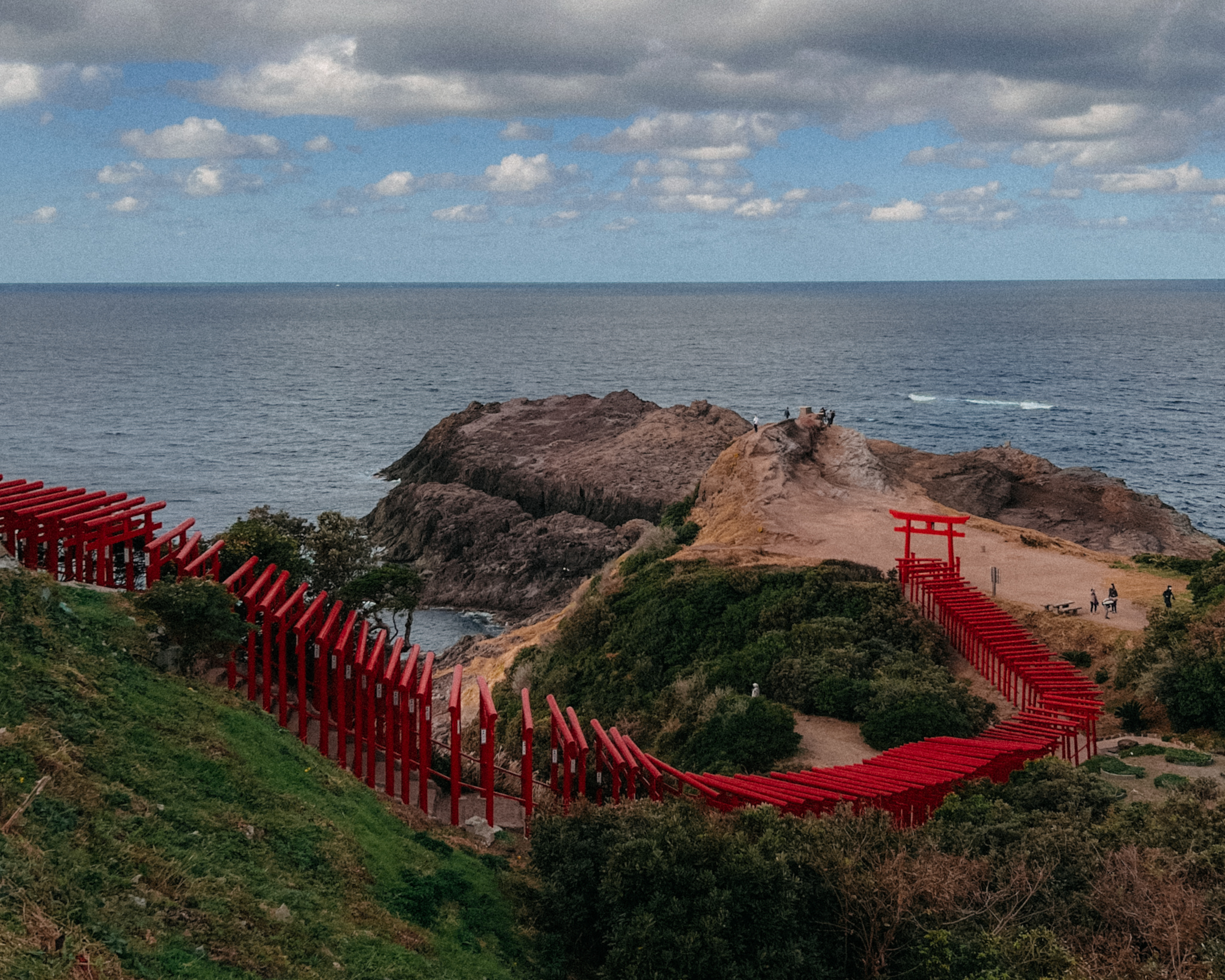
VISITS
On the third day, we switched Kyushu prefectures for Yamaguchi. It became clear to us that it was impossible to see all of Kyushu in just seven days, so we decided to concentrate on the northern part of the island. I chose to include Yamaguchi because it was easily accessible from Fukuoka and Motonosumi shrine had been on my bucket list for a long time. You'll soon see why it's so special!
TIPS FOR THIS DAY
To be honest, this day may not make much sense if you're not renting a car. If you're traveling by public transportation, I would recommend spending the day exploring Fukuoka or visiting any places in Saga that you didn't get to see the day before.
In addition to Kanmon bridge you can also find very nearby another Pokemon lid at this exact location. Note this down!
If you visit the Karato Market on a weekend, you'll be able to experience a lively festival, with all of the stores selling sushi to go. Enjoy!

Kanmon Bridge
Chasing Pokemons... lids!Before crossing Kanmon bridge, there is a small park with amenities such as a vending machine and toilets. And the most remarkable feature of this park is the special Pokemon manhole! This collaboration between the Japanese government and the Pokemon franchise promotes rural areas of Japan by allowing you to hunt for different manholes all across the country. Check the official website for more info.
The Kanmon Bridge connects Kyushu to Honshu, the largest island in Japan. We were both nervous and excited as we approached the bridge. On our way to Yamaguchi, we crossed the bridge by going under the sea. On the way back, we took the upper part of the bridge. Daniel may never admit it, but when I started singing "Under the Sea" from The Little Mermaid, he wasn't as amused as I was. He's a little bit claustrophobic.
ACCESSIBLE VIA PUBLIC TRANSPORT?
It doesn't make sense to travel to this location via public transportation unless you're a Pokemon fan. However, if you're traveling by car, it makes for a fun pit stop along the way.

Karato market
Eat the most fresh sushi at a marketKarato Market is a smaller version of the former Tsukiji Market in Tokyo. Instead of abundant tuna, you'll find the renowned fugu fish on display in every store. Our main goal for visiting the market was to enjoy a meal at one of its fresh kaiten sushi (sushi belt) restaurants. Be sure to check out the restaurant photos in the "Eating" section below!
ACCESSIBLE VIA PUBLIC TRANSPORT?
Yes.
From Hakata Station: It takes approximately 1 hour to reach the market. To get there, you should take the train to Shin-Shimonoseki Station, and then either a local bus or a taxi to reach the market.

Motonosumi shrine
Walk of toriis that lead to the seaBuilt in 1955 after a spirit fox conveyed a message to one of its residents, the Motonosumi Shrine boasts a total of 123 torii gates before reaching the sea. I can relate to the spirit's sentiment, as having a home perched on this cliff is truly special. Everything about this place, including the intense wind, left us in awe. I consider it to be one of the most unique places I've ever visited in Japan.
Make sure to ascend the small cliff, as you will be pleasantly surprised by what you find there.
ACCESSIBLE VIA PUBLIC TRANSPORT?
You will need a taxi for the final leg of the journey. Be sure to arrange for a round-trip with the taxi, as there will be no other means of transportation available to return to the station.
From Hakata Station: The total journey takes approximately 3 hours and 30 minutes. Take a train from Hakata Station to Shin-Yamaguchi Station, then a bus to Nagatoshi Station, followed by a train to Nagato-Furuichi Station. Finally, take a taxi to Motonosumi Shrine.
From Karato Market (if you're following this guide you may be here): The total journey takes approximately 2 hours and 15 minutes. Take a bus from Karato Market to Shimonoseki Station, then a train from there to Nagato-Furuichi Station. Finally, take a taxi to Motonosumi Shrine."

Tsunoshima bridge
An iconic sunset at the bridgeThe Tsunoshima Bridge spans the Sea of Japan, connecting the mainland with the island of Tsunoshima. In my opinion, the curved design of the bridge is incredibly photogenic, making it a fantastic location to catch a sunset. The view is even more breathtaking in person, as you can take in the beach, bridge, and island all in one stunning panoramic scene.
ACCESSIBLE VIA PUBLIC TRANSPORT?
Yes, but it's not feasible to get here for a sunset view.
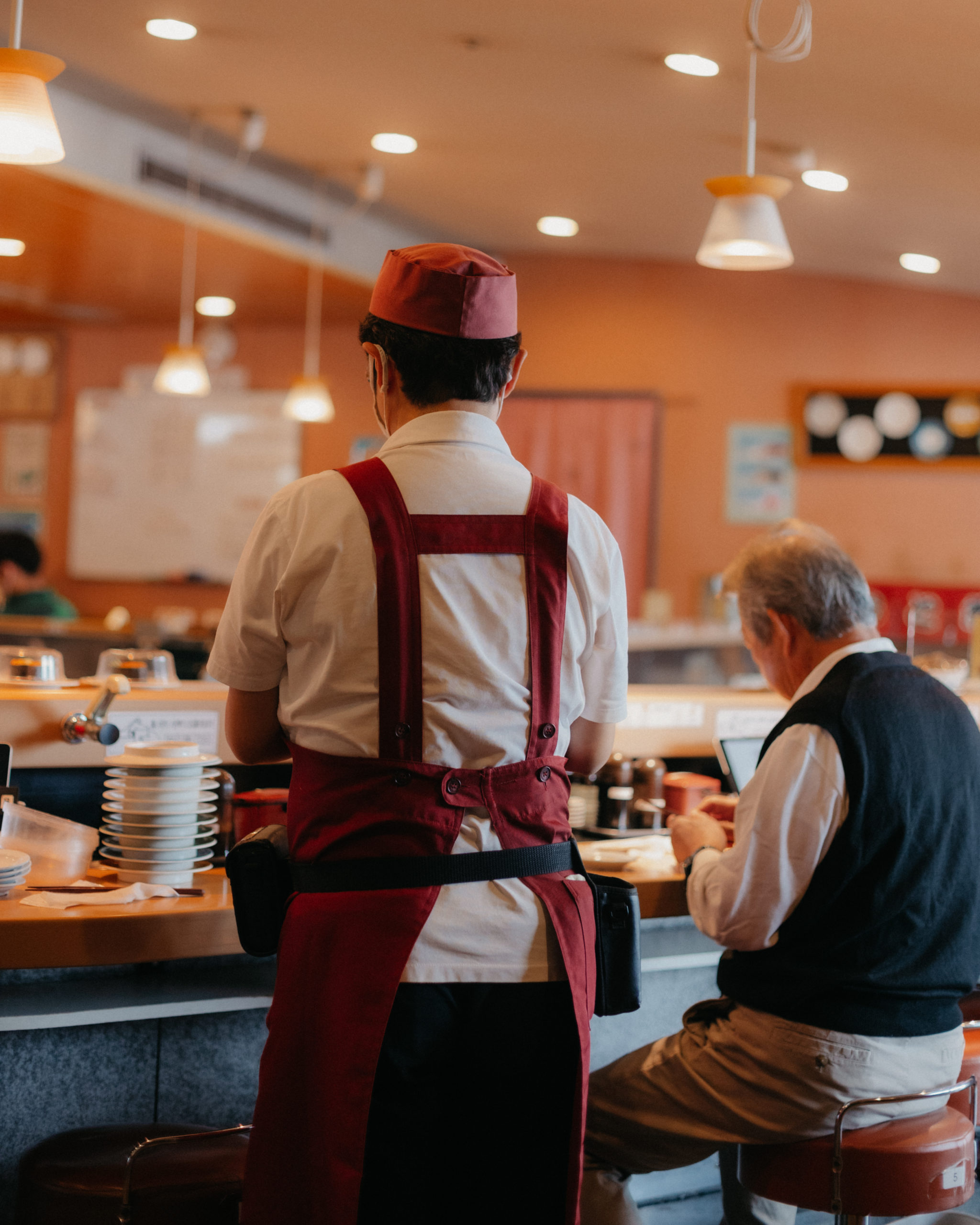
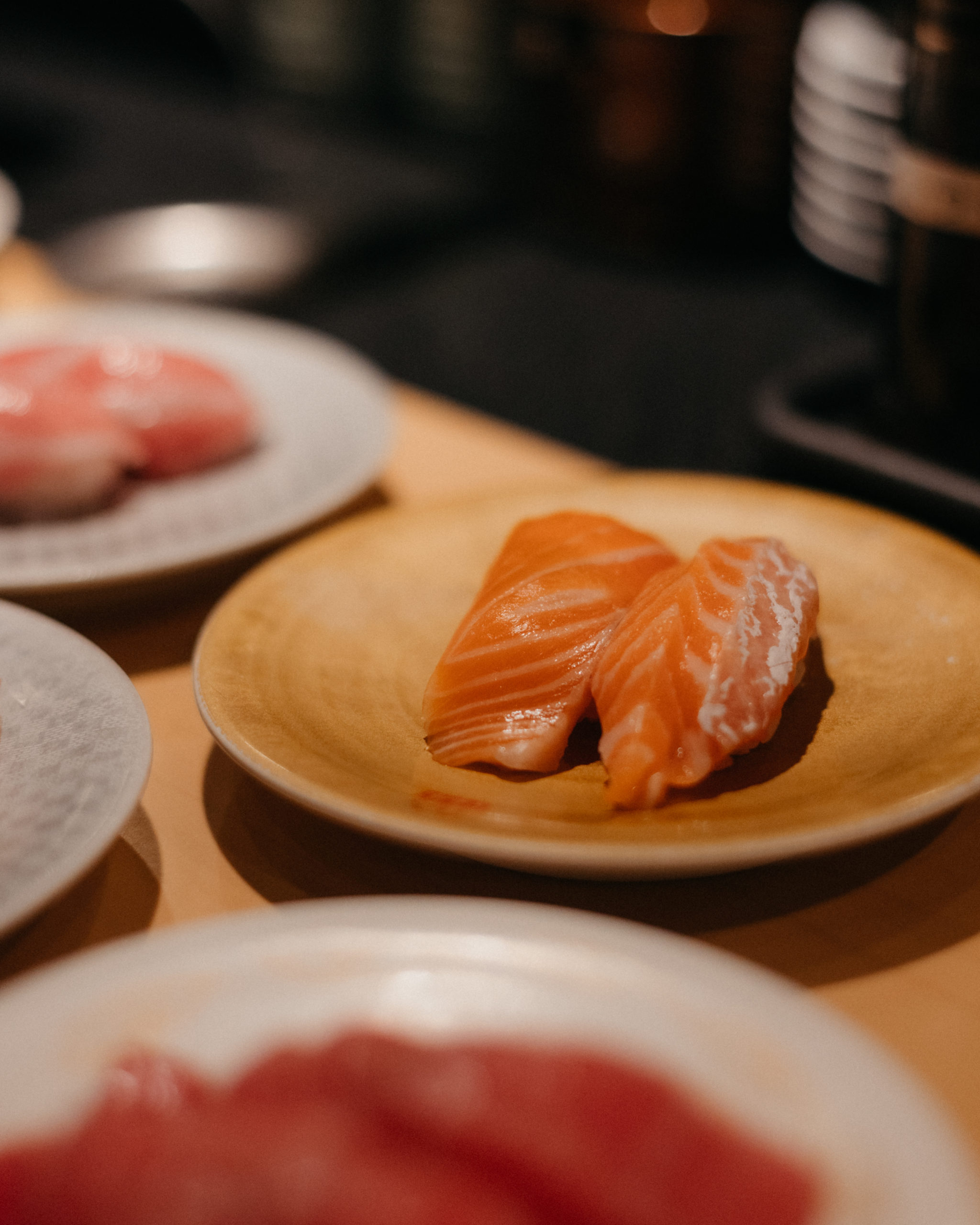
EATING
LUNCH
The Karato Market has a belt sushi restaurant that offers incredibly fresh sushi at a fair price. In addition to the outstanding food, which was the best I have ever tasted at a sushi restaurant, I was also impressed by its charming 70s/80s rural atmosphere, complete with vintage uniforms, clientele, and decorations. I would go back in a heartbeat, everything was perfect.
DINNER
Hakata ramen is one of the most beloved types of ramen in Japan, in fact the well-known Ichiran ramen chain originates from this region. We conducted some research and chose to try one of the most popular Hakata ramen restaurants, Shin Shin. As is typical of delicious ramen shops, be prepared to wait in line. The ramen at Shin Shin is full of flavor, not too heavy, and made with excellent, thin, homemade noodles. We highly recommend it, especially considering its affordability - you can enjoy a bowl for less than 6€, which is quite a steal by Barcelona standards.


DAY 4: Fukoka: Tanushimaru kappa station, Ukiha Inari Shrine, night in Yufuin - FUKUOKA PREFECTURE -

VISITS
On Day 4, we will be changing hotels and staying in Yufuin! This day is very road trip oriented, and we have selected two pit stops along the way to fully enjoy the views of Oita prefecture. Yufuin is a charming town nestled between mountains in the Oita prefecture, making the entire journey there scenic and beautiful.
TIPS FOR THIS DAY
It may be surprising but these two stops can easily be reached by public transportation with short travel times.
The day concludes in Yufuin. If you are traveling by public transportation, please refer to the next day's itinerary for information on how to get there.

Tanushimaru station
Eat a Kappa macaroon whileTanushimaru Station is a Kappa-themed station located in the town of Kurume. Did you know that you can visit several Kappa-themed locations in Fukuoka? Kappas are creatures (yōkai) from Japanese folklore known as sea monsters, and I have to admit that I find them fascinating. Not only is the station adorable, with old trains passing by, it also has a lovely cafe called Kappateria (what a perfect name! See below what we ate there). This was one of the best mornings we had during the trip!
ACCESSIBLE VIA PUBLIC TRANSPORT?
Yes! And it takes less than an hour from Hakata. Simply take a shinkansen from Hakata Station to Kurume Station and then transfer to a local train to reach Tanushimaru Station.

Ukiha Inari Shrine
Toriis to the sky and beyondBuilt in 1957, this shrine is dedicated to three deities and is renowned for its blessings of prosperity in business, good harvest, sake production, health, longevity, and academics - quite a comprehensive list, isn't it? The shrine is situated on top of a mountain and is approached by a series of red torii gates.
We parked directly on the top, so you won't have to worry about climbing all the stairs!
ACCESSIBLE VIA PUBLIC TRANSPORT?
Yes! It's very easy to reach from the previous stop (Tanushimaru Station) by taking a 30-minute local train to Ukiha Station.
From Hakata Station: The quickest route is 1 hour and 30 minutes by taking the Yufu Limited Express to Beppu, and getting off at Ukiha Station."


EATING
LUNCH
We had brunch at the stylish Kappateria cafeteria located in the fun Tanushimaru station. You may be surprised to learn that the cafeteria offers well-made dishes using local ingredients. We tried delicious Kappa macarons, a refreshing milk tapioca drink, and a fruity smoothie topped with cotton candy. For those who want a more substantial brunch or lunch, they also serve savory dishes.
DINNER
One of the perks of staying at a Ryokan is that both breakfast and dinner are often included in the room price. The meals at the Musouen are of excellent quality, which justifies the overall cost of the room. Keep in mind that you are being served a high-quality gourmet meal with each meal. Dinner at the Ryokan typically starts at 18:00, so it's important to plan accordingly and arrive at the hotel before that time. Our first dinner consisted of a main course of Kyushu designated origin black wagyu beef Yakiniku and an array of delicious side dishes, including sushi, making it an unforgettable feast.
As a curiosity, some Ryokans serve food in your room, while others have a separate restaurant facility. Usually, the latter option is less luxurious, but that's not the case at the Musouen, as the restaurant elevates the dining experience.
DAY 5: Oita: Yufuin, Musouen Onsen, night in Yufuin - OITA PREFECTURE -

VISITS
Visiting Yufuin should be at the top of your list when exploring Kyushu. The town is famous for its picturesque and rejuvenating hot springs, which are a result of the volcanic activity in the area. To fully experience Yufuin, consider finishing off your visit with a soak in one of its onsens.
On day 5, we took advantage of everything Yufuin had to offer. We marveled at the stunning autumn foliage in the town, then relaxed in the hot onsen at our hotel, The Musouen. Autumn in Japan is a special time, with the vibrant momiji (maple) leaves being just as beautiful as the cherry blossom in spring.

Yufuin
A town that looks straight out of a movieYufuin is a small town that is geared towards onsen tourists and is located in a beautiful green valley beneath Mount Yufu. During your visit to Yufuin, there are several must-sees, including the Kirin lake, the shops, such as the Donguri no Mori Ghibli store which is the most adorable Ghibli store I have ever been to, and the charming Miffy bakery. A walk alongside the river is also highly recommended for its gorgeous and peaceful scenery. We also tried the delicious meat croquette and matcha latte in Yufuin, but every shop has its own delectable options, so you'll be sure to find something you like!
One thing that can be skipped, surprisingly, is the Floral Village. It was a huge disappointment for us. While it does have a lot of Ghibli merchandise, the exploitation of animals (such as owls, cats, squirrels, and goats) for entertainment purposes was too much for us.
ACCESSIBLE VIA PUBLIC TRANSPORT?
Yes.
From Hakata Station: You can take a direct train (Yufuin-No-Mori 1Limited Express) from Hakata Station, which takes 2 hours and 15 minutes.
From Ukiha Station: If you've followed our previous guide, the last leg of your journey would be from Ukiha station. From there, take a train to Hita station and then transfer to the Yufuin-No-Mori 1Limited Express to Yufuin station, which takes 2 hours.

Musouen Onsen
Traditional stayThe Musouen is a traditional onsen hotel that provides guests with a true traditional hotel experience. The rooms are equipped with tatami mats and futons for sleeping and guests are provided with yukatas and sandals to wear throughout the hotel. The onsens are the main attraction and are divided into two: a women's bath with a stunning view of Mount Yufu and a men's bath divided into two sections. There are also two indoor private baths and two outdoor private baths, all surrounded by lush greenery, especially beautiful during the autumn season. Every evening, guests can enjoy a delicious and traditional kaiseki dinner featuring local specialties, and breakfast is also served in the traditional style.
If you are on a budget, I suggest visiting the public grounds of the hotel and purchasing a day pass for the onsens. It costs less than 10 euros and is definitely worth it, though you will need to bring your own towel. The onsens are open to the public from 10:00 am to 2:00 pm, so be sure to take advantage of this opportunity before having lunch and spending the afternoon in Yufuin.
One of the baths is closed for maintenance each day. The large women's bath is usually closed on Wednesdays, so be sure to plan accordingly so as not to miss it.
The Musouen is a traditional onsen hotel, so you'll get the best traditional hotel experience, meaning room with tatami and futons to sleep, plus the yukatas and sandals to wear in the premises of the hotel. The onsens are the big hit, Musouen has one big women's bath (amazing, with views to the Mount Yufu), one men's bath (divided into two), plus two open-air private baths and two indoor private baths. To go to one or the other onsen, you are surrounded by beautiful greenery that during autumn season is exceptionally beautiful. A part from that, each night you'll have a kaisikei dinner with local specialities that is beyond yummy and traditional breakfast too.
If it does not fit your budget, I encourage you to spend the morning in the public grounds of the hotel buying your day pass ticket to enjoy the onsens. It costs less than 10€ and it's so much worthy (you will need to bring your own towel). The onsen is open publicly only from 10:00 to 14:00, so make sure to do this first and then have lunch and spend the afternoon in Yufuin.
TIP:
One of the baths is closed for maintenance each day. The large women's bath is usually closed on Wednesdays, so be sure to plan accordingly so as not to miss it.

Onsen experience
Healthy hot spa watersThe Musouen is a top-notch onsen hotel that provides a traditional and authentic experience. With a total of six baths, including one large women's bath with breathtaking views of Mount Yufu, one men's bath divided into two sections, and two open-air and two indoor private baths, you are sure to have an unforgettable soak.
The women's bath is particularly spectacular, offering views of the sun rising behind Mount Yufu. I had the opportunity to visit early in the morning when the air was still foggy, and it was truly a unique experience watching the sun slowly clear the air and rise.
For those traveling with a non-same-sex partner or kids, the open-air private onsen, also known as the family bath, is a must-visit.

The private baths at Musouen are on a first-come, first-served basis, with a plaque outside indicating whether they are occupied or vacant. Simply flip the plaque when the bath becomes available. The private baths are smaller than the communal ones, but offer a more intimate and secluded experience, especially if you are traveling with a partner or family. There are indoor private baths available, but the open-air option is a unique and memorable experience.
It's important to familiarize yourself with onsen etiquette before entering. Clean yourself thoroughly in the showers before entering the water and use the small towels to cover your body. Once in the water, nudity is required. Soak a towel in cold water to help regulate your body temperature. If you have tattoos, check with the staff before entering the communal baths, but don't worry - you can always use the private baths regardless.


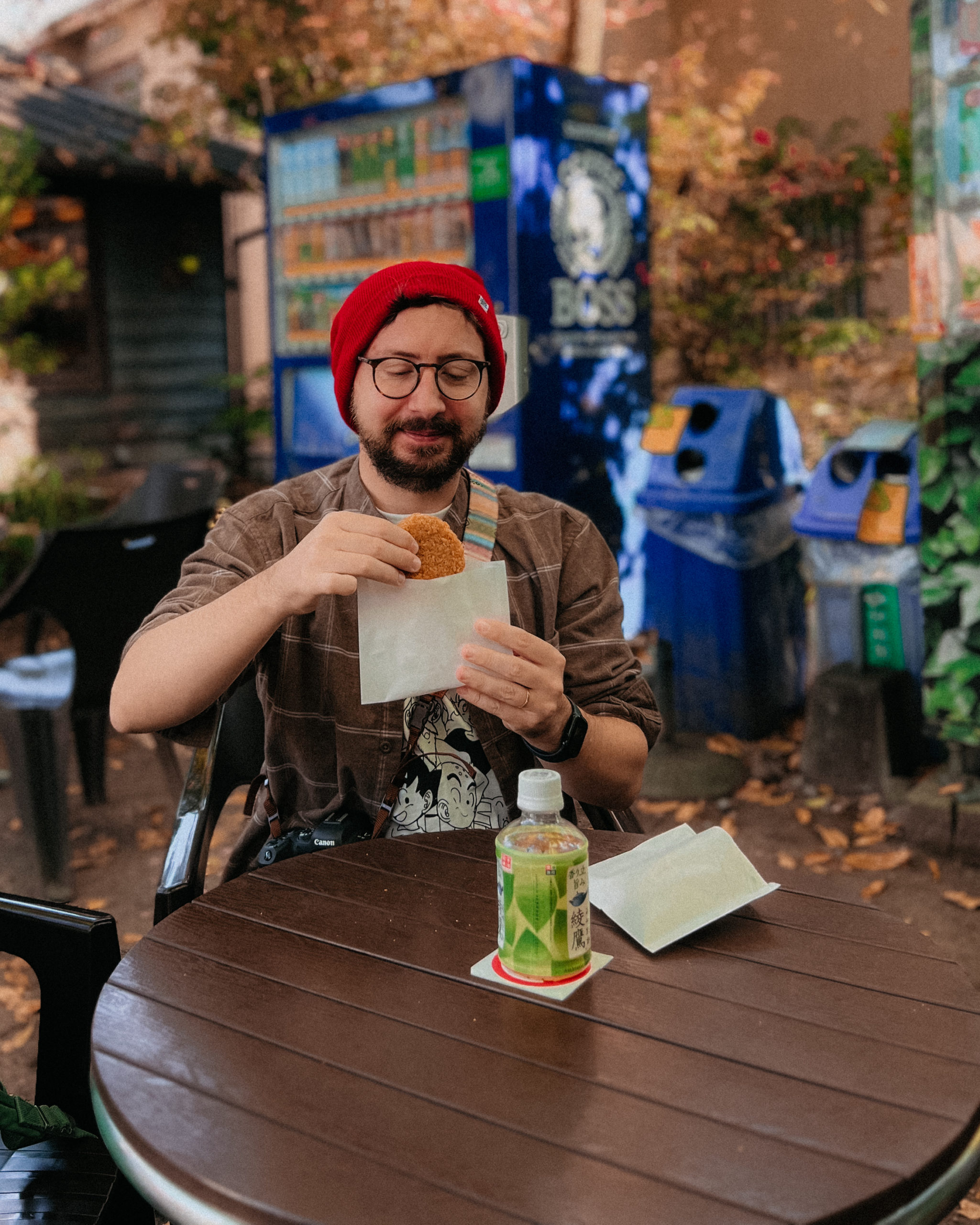
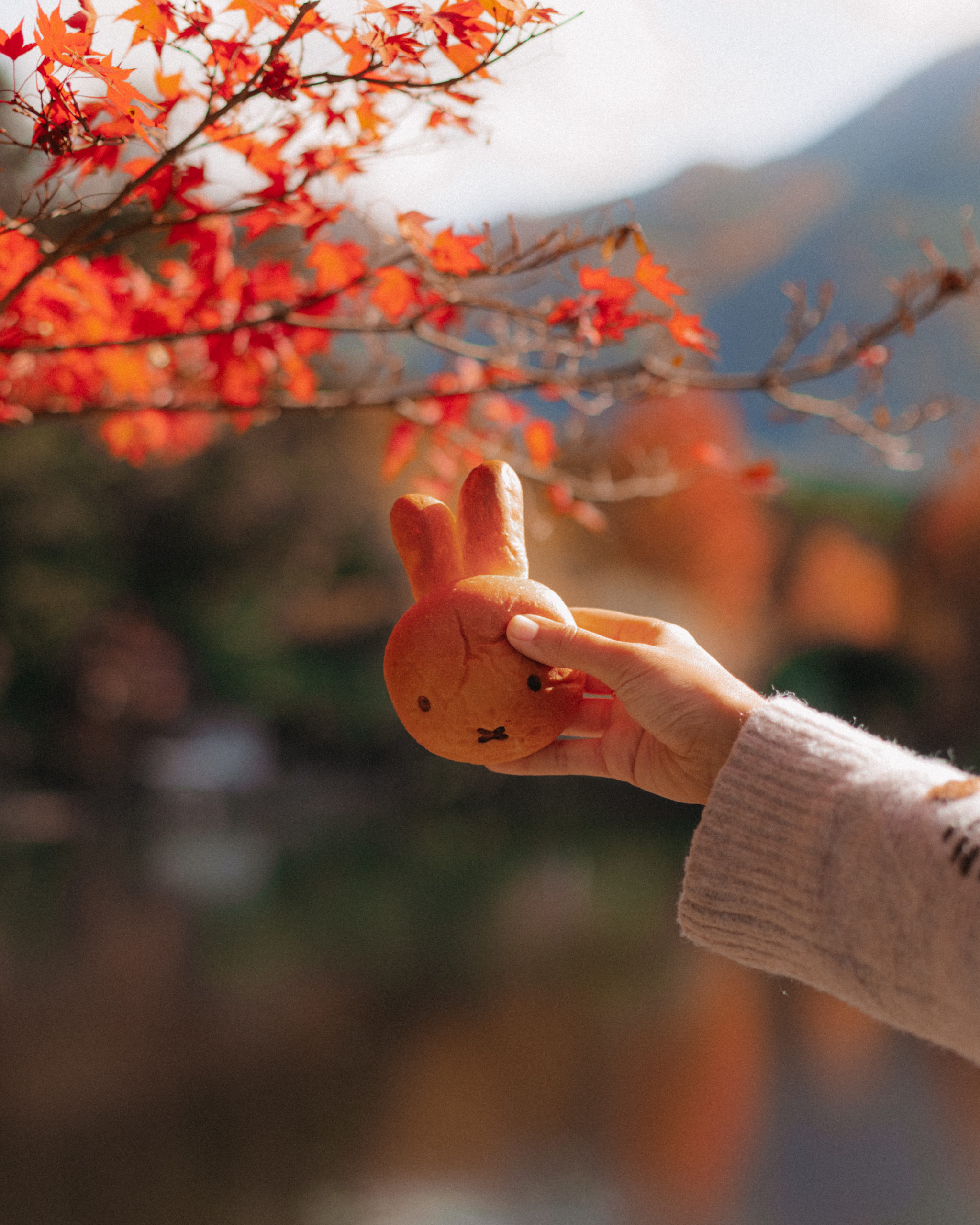
EATING
LUNCH
During our stay at the Musouen, which provided abundant breakfast and dinner, our lunch was more of a light bite. We tried two different meat croquettes, also known as "korokke." Korokke is similar to croquettes but the bread crumbs used are more of the panko style rather than the ones found in Spain. They are deep-fried and come with a wide variety of fillings, with beef being the most popular.
My strongest recommendation for snacking in Yufuin is to visit the popular Miffy Bakery. They sell out of their most popular items quickly, so make sure to grab your favorite early as they open from 9:30 AM to 5:00 PM. We had two buns, the Miffy Anpan (made with sweet red bean paste), my top recommendation (as seen in the photo above), and a savory curry bun (kare pan).
DINNER
For dinner, we had another fantastic "kaisikei" meal. This time, the main course was a Shabu Shabu, which is like a hot pot with vegetables and thin slices of meat. As usual, we were also served a large selection of small dishes that accompanied the meal, using fresh, local ingredients that were typical of the autumn season. The quality of the food and the outstanding service were top-notch. Every night, the server at our table asked us about our day and was very patient with our limited Japanese language skills. After dinner, we went back to the onsen before going to sleep.


DAY 6: Harajirino falls, Nabegataki Falls, night in Yufuin - OITA PREFECTURE -

VISITS
On our final full day in Oita Prefecture, we indulged in activities centered around water. We started off with a relaxing morning soak in the hotel onsen and then drove to two nearby attractions that feature waterfalls.
TIPS FOR THIS DAY
A car is necessary for these visits, and it's recommended to book your visit to Nabegataki Falls in advance. You can use the following link to make your reservation. Although we managed to secure a spot on the same day, it's a good idea to check availability at least a day prior to ensure your visit.

Harajiri no falls
The Niagara falls of JapanThe Harajirino Falls, described by the Visit Kyushu tourism team as the Niagara Falls of Japan, is a stunning 120-meter wide waterfall that appears to come from nowhere. It was formed 90,000 years ago during the eruption of Mt Aso, the main volcano in Kyushu. At the bottom of the waterfall, there are flatlands and a torii. The highlight of the falls during autumn is the beautiful contrast of the bright yellow ginko leaves against the waterfall. This hidden gem is a must-visit for anyone visiting Kyushu.
Don't forget to stop by the nearby store, where you can purchase local products. We bought delicious kabosu (citrus fruit, similar to yuzu) cakes during our visit and it's a great way to support local producers while also taking home unique souvenirs.
ACCESSIBLE VIA PUBLIC TRANSPORT?
No.

Nabegataki falls
Waterfalls hidden after a moutain trailThe Nabegataki waterfall is quite different from Harajiri, instead it is located in what seems like a secluded forest. It is a 9-meter tall waterfall and the trail leading to it is short and easy. One of the unique features of Nabegataki is that you can get behind the waterfall and view it from various angles.
Upon reaching the Nabegataki road, you will be greeted by rangers who will ask to see your admission ticket. Only those who show their ticket will be allowed to drive the final stretch of the road. After parking, you must show your QR code ticket again at the ticket office. Once your admission has been verified, you can begin the trail which is located downstairs and is well-paved in typical Japanese fashion, with wooden structures to help prevent slipping in the woods.
ACCESSIBLE VIA PUBLIC TRANSPORT?
No.


EATING
I would like to also highlight the bountiful breakfasts we took at Musouen. A traditional Japanese breakfast includes some unique items such as grilled fish and a variety of pickles. I have grown fond of this style of breakfast, especially while traveling as it provides ample energy for the day ahead. The breakfast usually comprises of an egg, rice, soup, fish, and vegetables.
On our final night at Musouen, we had Sukiyaki as the main course which is my favorite Japanese dish. One tip at Musouen, if you are spending multiple nights they will let you choose your main dish for each dinner,and in my opinion, Sukiyaki and Yakiniku are the best options to go for.
DAY 7: Beppu, night in Fukuoka - OITA & FUKUOKA PREFECTURE -

VISITS
Today, we say farewell to North Kyushu, but we couldn't leave without visiting its most popular city: Beppu. Our day will be spent exploring the famous onsen hells, followed by a drive to Hakata (Fukuoka) to return the rental car, and end our journey with a dinner at the well-known Canal City mall in Fukuoka.
Ready to end the adventure? I am crying already.
TIPS FOR THIS DAY
If you are traveling by car like us, you can enjoy free parking in front of Umi Jigoku. From here, you can visit both Umi Jigoku and Oniishibozu Jigoku, and then drive to Chinoike, which is located further away from the other sites. There is also a large, free parking lot available in front of Chinoike.
For those traveling by public transportation, local buses are available, or you can opt for a tour of the seven hells.
Unfortunately, we did not have enough time to experience it, but Beppu is also known for its sand baths. For more information, simply search "Beppu Beach Sand Bath" on Google. It promises to be a unique and unforgettable experience.

Beppu Hells
Colorful hellsThe most renowned attraction in Beppu is the "7 Hells," where you can purchase a ticket to visit all seven of them. However, after doing some research, we discovered that at least one of them, where real crocodiles are kept and fed, was not a form of tourism that we were willing to support. As a result, we narrowed down our visit to three that stood out to us as unique from each other: Umi Jigoku, Oniishibozu Jigoku, and Chinoike Jigoku.
The "Hells" are onsens, or hot springs, that reach temperatures of up to 100ºC, which is much hotter than the typical 40ºC of the onsens that you can bathe in. In my opinion, Umi Jigoku is the most beautiful of them all, especially for its milky blue water and the fact that it also features a red hell and a water lily greenhouse. The various colors of the hells depend on the minerals in the ground.
ACCESSIBLE VIA PUBLIC TRANSPORT?
Yes.
From Yufuin: The total travel time is 1 hour and 30 minutes. You'll need to take two buses, the first one from Yufuin to Beppu Koen stop, and then an internal bus towards Umijigoku stop.
From Hakata Station: The total travel time is 2 hours and 33 minutes. The first leg is a train ride to Beppu Station, and then you'll need to take the same internal bus from Beppu Koen stop to Umijigoku stop.

Canal City Fukuoka
Enjoy a Japanese shopping mallCanal City is not just an ordinary mall; it boasts an interesting, colorful architecture that blends arches, lines, water, and greenery. Additionally, don't miss out on the character shops, featuring popular franchises such as Ghibli, Sanrio, Ultraman, Jump, Disney, etc. The highlight of Canal City, however, is the Taito Station with the Bandai Namco store, where you can shop in a forest of gacha machines or play arcade games. We had a lot of fun there!
Another exciting aspect of Canal City is the projection and fountain show. We saw a Gundam show, but it changes periodically. At the time of writing this, the show is based on One Piece.
ACCESSIBLE VIA PUBLIC TRANSPORT?
Yes. Walkable from any Hakata spot.


EATING
For lunch, we took advantage of the convenient konbini stores, but for dinner, we had a truly unique dining experience at a themed restaurant: Kirby's Cafe! If you plan on visiting, be sure to make a reservation in advance, as walk-ins are not an option. These types of cafes are not known for their food quality, as the focus is on the appearance and overall atmosphere. However, I believe the unique experience is well worth reserving a table. I don't think you'll find anything like it anywhere else in the world. After our dinner, we thought that it was better to just stick to drinks and desserts. They also have a charming store with exclusive merchandise.
GOOGLE MAPS
I am including a Google Maps link below. The pink pins represent all the places to visit and eat that are included in the guide, while the yellow pins indicate nearby locations that I didn't have a chance to visit but had on my radar.
Thanks for travelling with us to North Kyushu! If you have doubts organizing your own travel to Kyushu, leave a comment here or contact me through Instagram's DMs but let me know you have checked the blog!


Thanks !! Just found your blog & thanks for its super quality! We will be driving over Kyushu in about one month on our way back to Tokyo (coming from a stay in Amami) so we will drive from Kagoshima to Tokyo. But we just have 6 days to do the whole way ;-) it is our 20th (approx) travel in Japan so …
Will take the time to somehow build an itinerary & for sure might have question for some tips! Merci beaucoup ! Leila
Thanks Leila! Sounds great! If you have any questions feel free to contact me through here or Instagram DMs also if you are coming from Kagoshima consider Takachiho in your itinerary too ❤️
This is Dani, Juno & Damaris.
Our heads are full with photography,
our hearts stay in Japan.
Our guides
2 weeks in Japan. Highlights, food recommendations, shopping & the most perfect getaways!
Visit Porto in 48h! Probably one of the most beautiful cities in the world
Visit Lisbon in 48h! A complete guide with the most beautiful places to visit, eat and shop
Our tiny foodie guide for a full-belly long weekend!
Visit the most charming area in England using public transportation
Eat your way through New York City, & more! Check our favorite spots from one of our favorite places in the world
Spend 3 days admiring the colorful houses of these 5 lovely Italian coastal towns.
Top posts this month
YOUTUBE
Instagram
Pinterest
GET OUR POSTS IN YOUR MAIL
To find out more, including how to control cookies, see here: Cookie Policy